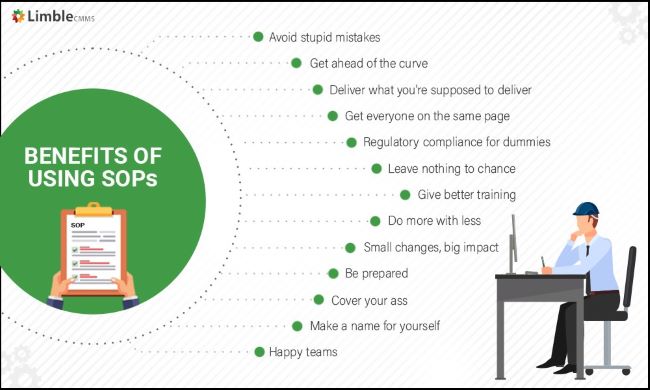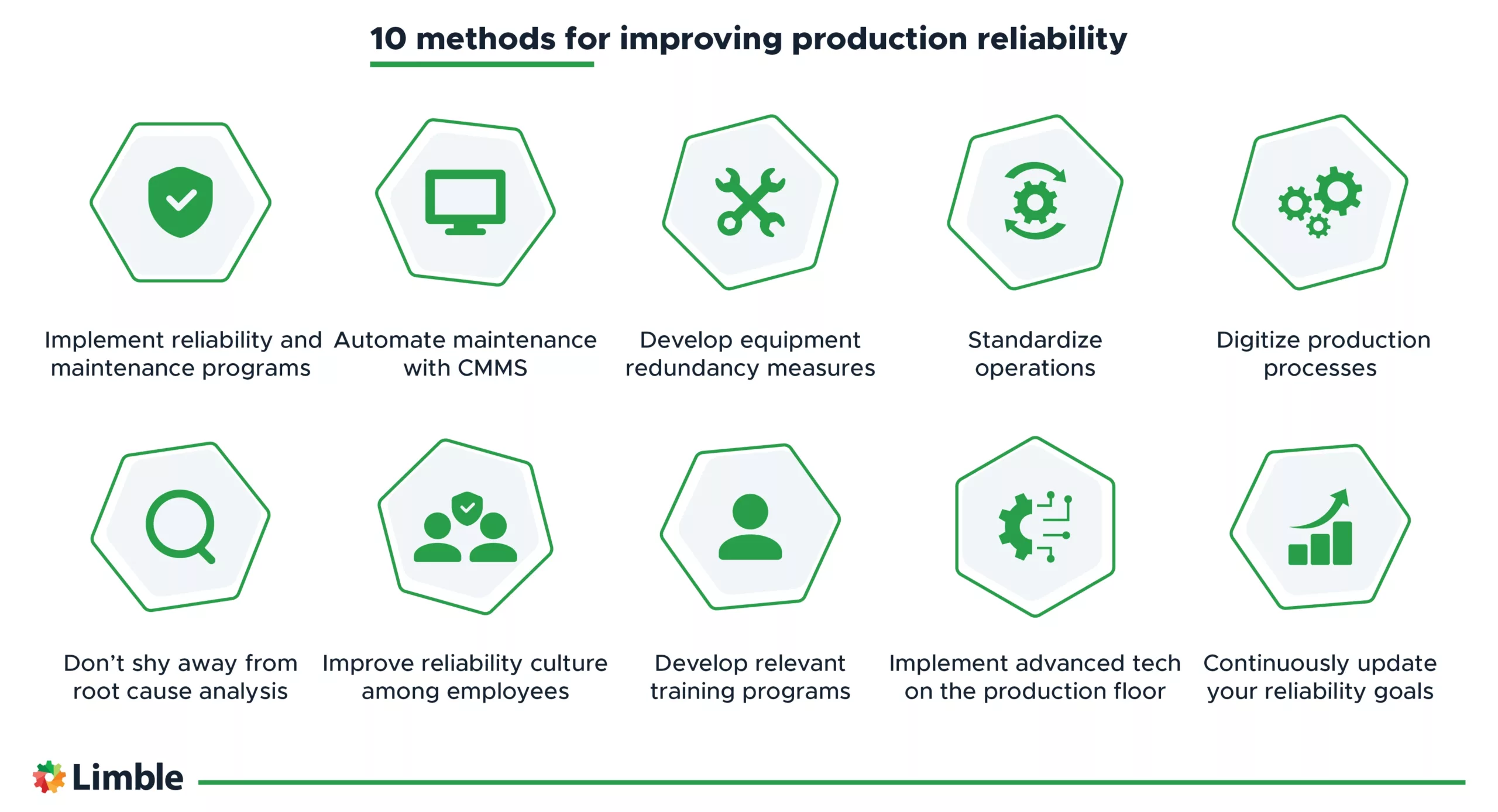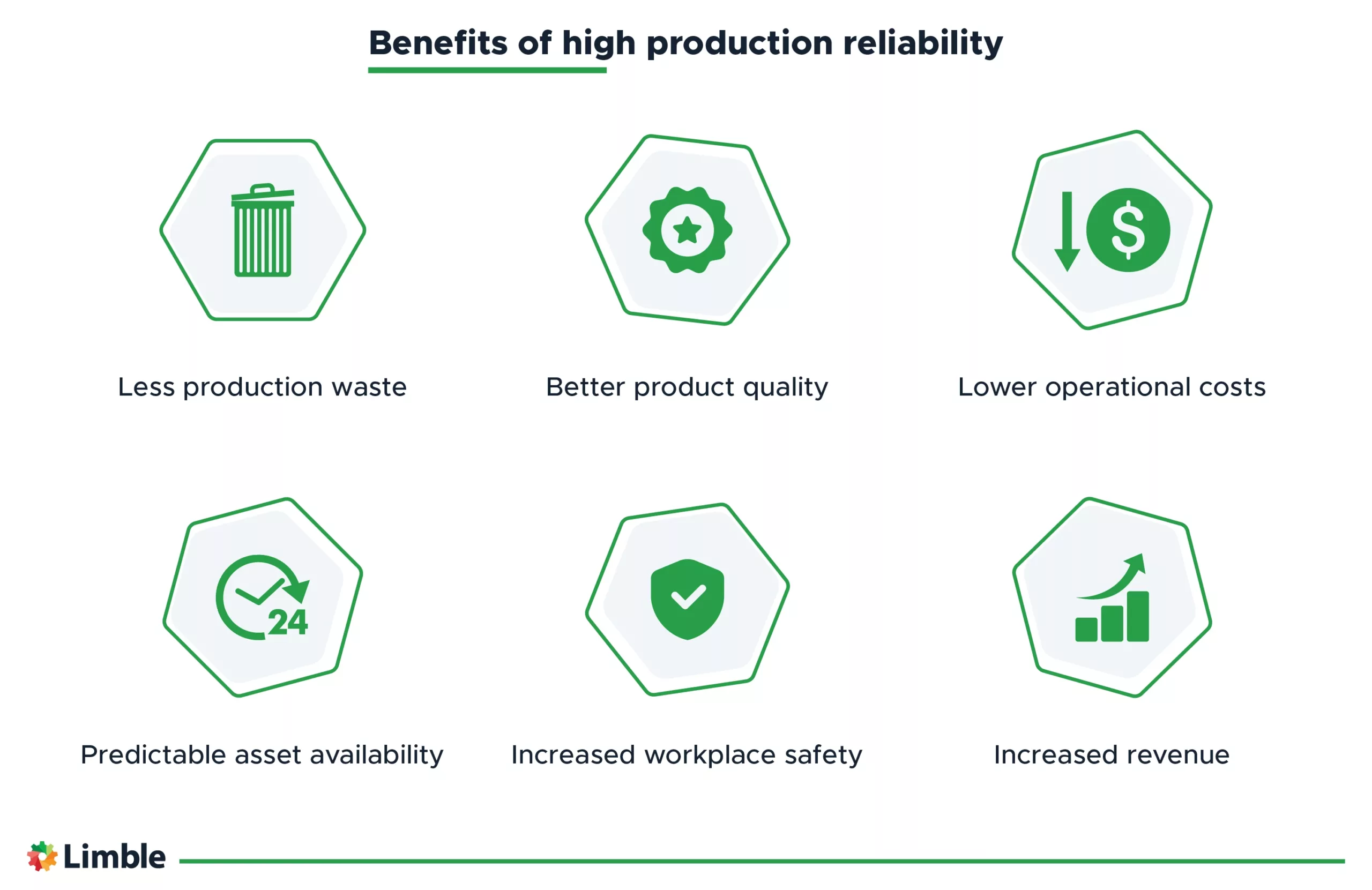Are production delays, process interruptions, and frequent machine breakdowns dealing a blow to profit margins at your facility?
Improving production reliability could help you solve all of those problems.
In this article, we’ll cover:
- The basics of production reliability
- How to measure reliability in manufacturing
- 10 methods you can use to achieve high production reliability
What is production reliability?
Production reliability measures the efficiency of individual machines on the production line and the dependability of different manufacturing processes.
When production reliability is high, that means your manufacturing equipment is doing its job well to produce good products at a predictable rate.
Even small problems with production equipment can cause big problems with production rates, high equipment failure rates, product quality, and production costs.
Checklist for Creating a Preventive Maintenance Plan
Following a consistent Preventive Maintenance Plan can make life easier. Use this checklist to create your own!

How maintenance impacts production reliability
A lack of proactive maintenance and poor maintenance practices lead to frequent machine breakdowns. This prevents companies from achieving desired product quality and production rates.
Production reliability is also affected by process optimization.
Process optimization and data-driven maintenance strategies increase production reliability scores, helping you establish a profitable and competitive production facility.
Manufacturers need to find and eliminate non-value-adding activities that only increase turnaround times.
How to measure production reliability
Manufacturers use two main metrics to measure production reliability:
- Overall equipment effectiveness (OEE) compares the actual performance of production assets against their ideal performance. It looks at an individual machine/system and calculates its equipment availability, performance, and quality.
- Overall Production Reliability (OPR) measures the dependability of the manufacturing system as a whole. It takes into account the OEE scores of all assets on the production floor and gives you the average OEE for your whole facility.
Access to long-term process and equipment performance data makes it easier to identify production bottlenecks and determine how particular production patterns impact manufacturing consistency and quality.
10 methods for improving production reliability
Below are our top 10 recommendations for improving production reliability.
1) Implement strong reliability and maintenance programs
Improving production reliability means looking beyond equipment availability.
Here are some ways companies can improve production reliability with maintenance programs:
- Streamlining maintenance programs by paying closer attention to equipment failure modes and effects, and improving asset life cycles and equipment durability and maintainability.
- Establishing reliability-centered maintenance to understand the operation of different production systems, how their failures occur, and the effect of asset failure on production quality.
- Focusing on failure elimination and preventive maintenance instead of only corrective measures.
- Implementing total productive maintenance (TPM) measures for more predictable production. This involves training operators to troubleshoot and fix basic equipment errors, perform routine maintenance like cleaning, pre-production checks, and lubrication, and similar.
2) Automate maintenance with CMMS
Automating maintenance can significantly enhance asset performance and the quality of performed servicing tasks.
Using CMMS to automate maintenance brings a lot of benefits:
- Improved scheduling, data-collection, and maintenance-related inventory management.
- Timely maintenance alerts that enable technicians to initiate planned breakdowns.
- A centralized database containing detailed maintenance guidelines and equipment repair manuals for technicians to access and follow.
- CMMS can generate automated maintenance reports to track maintenance costs and stay on top of your maintenance KPIs.
- In-depth data that helps with reliability engineering, identifying opportunities for improving maintenance workflows, minimizing equipment and process downtime, and optimizing asset performance.
3) Develop equipment redundancy measures
Developing redundant production systems enables companies to maintain production rates irrespective of system failures. This gives manufacturers ample time to perform failure analysis and troubleshoot system issues without altering production schedules.
For example, manufacturers can install two separate power systems in their facilities. When one of the systems fails, the other one is automatically activated. This ensures the facility has an around-the-clock power supply to keep production running.
The main disadvantage of equipment redundancy is the cost of purchasing backup equipment. Therefore, redundant systems should be applied based on process and equipment criticality analysis.
4) Standardize operations
Standard operating procedures improve production reliability by:
- Helping manufacturing teams to avoid mistakes and transfer of errors that compromise production quality.
- Enabling different teams to deliver their targets using as few resources as possible.
- Simplifying complex production procedures, making them easier for employees to understand and follow.
- Fostering consistency among employees. Companies can expect similar results regardless of who is performing the task.
Manufacturers can develop facility-specific SOPs detailing machinery startups. Operators fill in a pre-production checklist and follow specific procedures to start and warm up machinery before starting daily production.

In essence, SOPs ensure everything is done the right way on the first try, leading to higher OEE on a leaner budget.
5) Digitize production processes
Digital systems collect data that manufacturers can leverage to improve quality inspections, increase equipment utilization rates, and track real-time asset performance.
Digital transformation inevitably leads to:
- More automation
- Increased precision on the shop floor
- Increased efficiency in complex activities that were previously performed manually
Take product packaging as an example. Manufacturers can develop a system that autonomously performs quality inspections, and sorts finished products before packaging. Such a system can identify production defects and errors, generating alerts when particular quality thresholds are exceeded.
Through digitalization, manufacturers can sustainably raise yield and implement data-driven quality improvements.
6) Don’t shy away from root cause analysis
How do you address equipment or process issues causing production interruptions? Does your maintenance team just fix equipment failures as they happen, or do they strive to identify the underlying causes of recurring problems?
A good maintenance strategy focuses on eliminating the root causes of process disruptions and recurrent equipment failures.
Root cause analysis (RCA) improves production reliability by:
- Minimizing downtime: Identifying underlying causes of failure makes it easier to eliminate these issues, resulting in greater asset availability.
- Maximizing asset lifespan: Eliminating underlying issues will increase the lifespan of critical production assets. RCA reduces the need for costly equipment repairs and replacements, reducing capital costs and making it possible to predict asset productivity.
- Increased efficiency: It enables companies to identify and combat production inefficiencies. This can reduce quality issues and maximize output from different processes and equipment.
RCA is an equipment-specific process. You can use it to identify the root cause of safety issues, production bottlenecks, process errors, and more.
7) Improve reliability culture among all employees
Achieving production reliability is a collective responsibility. It demands the participation of employees at all levels of the company – not just shop floor operators and maintenance technicians.
The senior management should educate all employees on the benefits of high production reliability and how it affects their paychecks and daily work.
Companies can improve a reliability culture by:
- Appointing sectional heads to spearhead reliability programs in different sections of the facility. Senior and mid-level management should lead by example to expedite the adoption of reliability-centered production behaviors.
- Investing in advanced training programs to strengthen a reliability culture among employees.
- Frequently updating employees on the progress of reliability programs and explaining how individual contributions contribute to those success stories.
8) Develop relevant training programs
Improving production reliability might require an investment in advanced work tools, employee upskilling, changes in work culture, and staff reorganization.
The goal of your training program is to help your employees get ready for these changes. A ready workforce is more adaptable to change and can effectively optimize workflows for better production reliability scores.
That is especially true when we talk about digitalization. Be it condition monitoring equipment, a new CMMS software, or visual quality control technology, proper training is the only way to maximize ROI from those investments.
Review the quality of your current training programs and existing skill sets. Define where you want and need to be in a year. Prioritize training to fill in the gaps.
9) Implement advanced tech on the production floor
Artificial intelligence and machine learning play an increasingly important role in:
- Process optimization: Manufacturers can leverage AI and machine learning data to optimize processes, streamline supply chain systems, and reduce production-related disruptions and delays caused by supply chain interruptions.
- Quality control: AI systems analyze production data and develop quality control databases, helping companies unearth potential quality issues asap.
- Predictive maintenance: Machine learning models analyze data collected by condition-monitoring sensors to track equipment-performance patterns and predict when failure is likely to occur. Maintenance teams can act at just the right time to avert such failures and prevent production interruptions.
All of these technologies help manufacturers build resiliency in volatile markets – if they can afford them.
10) Continuously update your reliability goals
Relying on old production reliability goals creates a false sense of success.
Whenever a company achieves specific targets, it has to establish new reliability goals. The goals should be realistic and align with the overarching business objectives.
Update your reliability goals, decide how you will measure the progress, and set in motion new reliability initiatives. Communicate that among employees to ensure everyone is on the same page.
The Essential Guide to CMMS
Download this helpful guide to everything a CMMS has to offer.

The benefits of improving reliability in manufacturing operations
While it requires a significant effort, improving manufacturing reliability leads to major benefits that are hard to ignore:
- Less production waste: Companies enjoy more predictable production schedules. They eliminate the frequency and severity of unscheduled breakdowns, reducing in-process waste and the number of defective products.
- Better product quality: Improving production reliability means everyone on the production floor participates in quality improvement. Anyone can detect and report early equipment anomalies or sub-par raw materials.
- Lower operational costs: Enhancing production reliability means less downtime and fewer machine repairs. The results are sustainable energy consumption, lower maintenance costs, and proper utilization of raw materials.
- Predictable asset availability: Increased asset availability affects the on-time delivery of quality products. It simplifies production planning and scheduling by making sure your assets will be ready and available when needed.
- Increased workplace safety: Improving production reliability translates to better workplace safety and compliance. Companies reduce machinery emission levels and ensure production assets operate within safe limits — low noise, sufficient protective guards, and no releases of hazardous energy.
- Increased revenue: Optimized production reliability streamlines all manufacturing processes. This leads to higher first-pass yields and optimized production rates, at a lower cost.
Achieving high production reliability is an investment that takes time. You need to continuously work on identifying and solving issues that cause manufacturing inconsistencies.
Improve manufacturing reliability by optimizing factory maintenance
More often than not, production reliability suffers because of equipment-related issues. The easiest way to solve those is to implement Limble CMMS and take factory maintenance to the next level.
To learn how Limble can organize, automate, and simplify your maintenance operations. Get a quick product walkthrough, start a free trial, or reach out to our amazing support team with specific questions.


